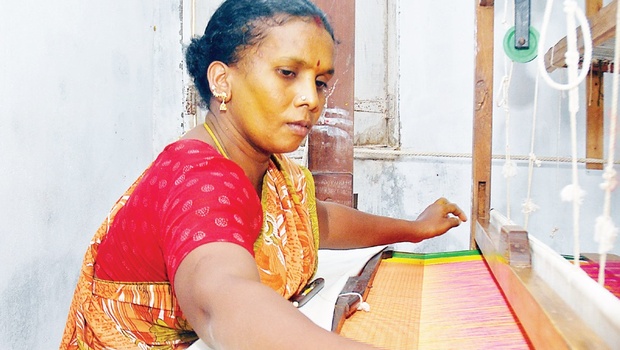
Chennai :
The sunny weaver enclosure of Pillayar Koil Sandhu, Kancheepuram somehow feels empty. There are no spinning wheels or bamboo ‘Paruttam’ outside homes. Nothing to show these are homes of weavers. The only give-away is the lone man stretching out the dyed silk threads under the sun at the end of the narrow cemented lane.
“Many have left. We used to have as many as 2,000 weavers in every society besides the many private contract weavers,” rues S Ganapathy, a fourth generation weaver. “Now, there are less than 10,000 in this town.”
Many causes surface: unable to pay their children’s hefty college fees, unable to build or buy a house, low wages, etc are some of reasons this reporter heard. It’s not just the weavers who are in dire straits. Even those that used to pedal away on a second loom (usually bought with a wife’s membership in a society or through private contracts) are worse off.
These men and women are, in the purest sense of the word, ‘Coolie workers’, even if they bring to life wonderful patterns and designs on the rich Kancheevaram silk.
Selvi knows this all too well! Despite frequent complains of back-ache and fatigue, the 40-year-old mounts on the loom and pulls at the Jacquard machine to bring forth her weave to embed another stretch of yellow silk. She keeps at it for 8-10 hours a day for a pay that could maybe buy her family of four a single meal at a cheap eatery.
But Selvi worries about none of that. She pedals on, taking the situation in a different light than one would assume. “It’s alright. With the radio on, it’s a lot of fun. We don’t even feel the hours passing,” she smiles.
For many workers like her in this town, weaving is the only trade they know and silk is the only language they speak. There are hundreds like her dotting the silk town, quietly working away in the background.
But her optimism doesn’t change reality. She still has two daughters to raise and educate. Her husband works at a paint shop and does odd jobs and it’s a joint struggle to put food on the table.
For men, who have suffered loss of a gradually waning tradition, other quick-pay jobs in the offing lead them away from their long-trusted loom. Former silk weavers now do manual labour and work inside factories to make ends meet. The elderly have taken to work as security guards in offices and industrial estates.
“They have to worry about things like a salary and raising family. Some of our men in the community aren’t even getting marriage alliances. During my grandfather’s time, it was a pride to belong to this lineage of silk makers. No one wants to marry a silk weaver anymore,” avers Swarna, a weaver. “Situation has changed far too much in the last decade or so. People lack a sense of pride in taking up weaving. Everyone wants their children to go to college, not sit with them and work.”
There is an elderly worker pedaling away at the clack-clacking machine in her family’s shed. They’re chattering cheerfully, but the exhaustion is apparent. Comfortable retirement is an illusion for most. All they can hope for is more years of crafting beautiful and world-renowned silk sarees…the only livelihood they know.
source: http://www.newindianexpress.com / The New Indian Express / Home> Cities> Chennai / by Amrutha Varshinii / October 21st, 2015